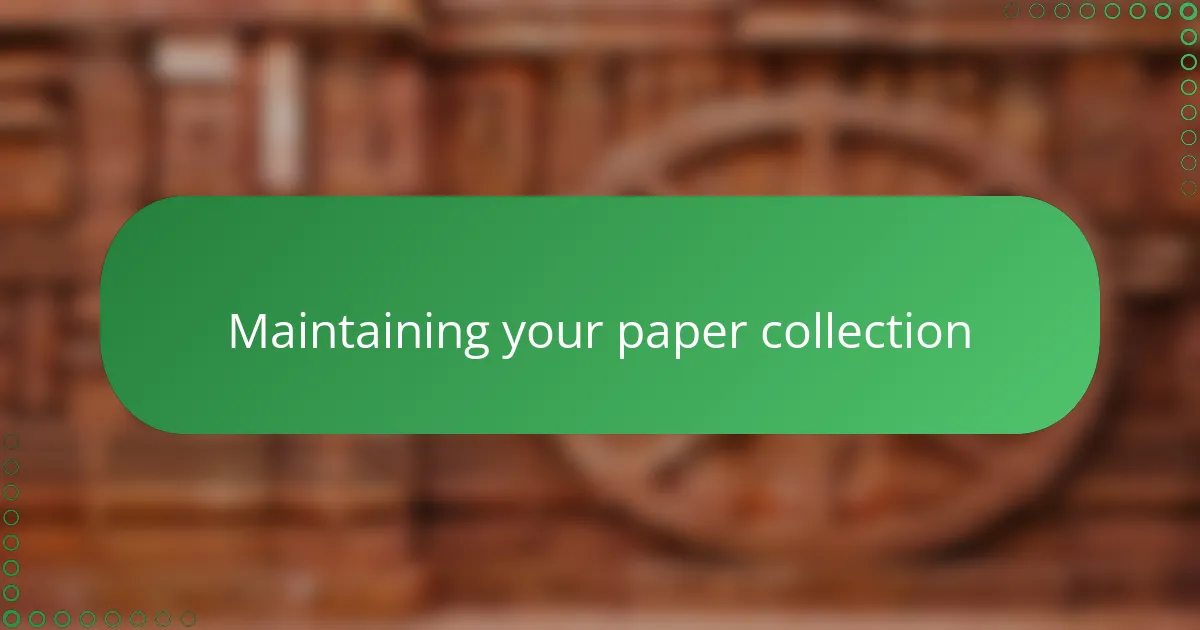Key takeaways
- Patterned papers can evoke emotions and memories, influencing the tone of creative projects.
- Effective sorting and organization of patterned papers by theme and color can inspire creativity and save time during crafting.
- Proper storage and maintenance of patterned papers help preserve their quality and vibrancy, extending their usability for future projects.
- Experimenting with different patterns and trusting one’s instincts can lead to unexpected yet harmonious combinations in crafts.

Understanding patterned papers
Patterned papers are more than just decorative materials; they carry moods, stories, and textures that can transform a simple craft into a heartfelt creation. I often find myself drawn to certain patterns because they evoke memories or feelings — a soft floral might remind me of a summer garden, while bold geometrics energize my workspace. Have you ever noticed how the right pattern can instantly set the tone for your project before you even begin?
What’s fascinating about patterned papers is how versatile they are. Some have subtle textures that invite touch, making your craft feel more tactile and personal. From my experience, understanding these nuances helps me decide how to layer and combine papers, avoiding clashes that distract rather than complement. Isn’t it amazing how tiny details like these can change the entire look and feel of a handmade piece?
When I arrange my patterned papers, I also think about scale and balance — the size of the print and how busy it feels next to others. Over the years, I’ve learned to mix small, intricate patterns with larger, bolder ones to create harmony. This understanding didn’t come overnight; it was through trial, error, and observation that I developed an intuitive sense for what works, which now guides my creative choices effortlessly.

Choosing patterned papers for crafts
Choosing patterned papers is always a bit like curating a mini art collection for me. I ask myself: Does this design speak to the story I want to tell? Sometimes, a delicate vintage print instantly transports me back to childhood afternoons, making it a perfect choice for sentimental projects.
Texture plays a surprising role in my selection too. I’ve found that papers with a subtle linen or embossed feel add depth and invite touch, turning a simple card or scrapbook page into something that feels truly crafted by hand. Have you ever noticed how your fingers almost want to linger on textured paper?
I also pay close attention to color harmony. Even if a pattern is stunning on its own, it needs to work with the other colors in my palette. When I began, I often picked papers because I loved each one individually, but now I think about how they converse with each other — a soft pastel print paired with a muted print can create a peaceful vibe, while contrasting colors amp up the excitement. Does that balance make your project sing, or sound more like noise?

Sorting patterned papers effectively
Sorting patterned papers effectively means more than just stacking them neatly; it’s about creating a system that sparks inspiration whenever I open my drawer. I like to group papers by theme—florals together, geometrics in another pile—because it mirrors how I think about my projects. Have you tried sorting this way? It surprisingly saves time and helps your ideas flow.
Color is another big factor for me. I arrange papers from light to dark or warm to cool tones, which makes it easier to spot the perfect shade when I’m mid-creation. Sometimes, this visual gradient even jumps out at me, inspiring unexpected combinations I wouldn’t have tried otherwise. Isn’t it amazing how organization can fuel creativity?
Lastly, I keep texture and pattern scale in mind when sorting. Thick, textured papers often get their own section since they require special handling, while tiny prints sit together so I can balance them with bolder designs later on. Over time, this careful sorting has prevented a lot of last-minute frustration and helped me maintain a harmonious stash that feels like a treasure trove rather than a mess.

Organizing patterned papers by theme
When I organize my patterned papers by theme, I find it helps to think of each group as a little story waiting to be told. Grouping florals together, for example, instantly brings a sense of softness and nostalgia, while seasonal themes like autumn leaves or holiday motifs spark ideas for timely projects. Have you ever noticed how themes can quietly guide your creative mood even before you start cutting and gluing?
I’ve also realized that organizing by theme saves me from that frustrating moment when I’m hunting for the “right” paper and can’t quite remember where I put it. When my winter prints are all neatly gathered, I don’t waste time flipping through random stacks, and instead, I dive straight into the vibe I want to create. There’s something deeply satisfying about having a clear thematic flow that just clicks with your inspiration.
Sometimes, grouping papers by theme can reveal surprising connections I hadn’t seen before. For instance, placing nautical patterns next to soft blues and sandy tones makes me think of beach days and summer memories, even if the papers came from different collections. Doesn’t it feel like organizing this way breathes new life into your stash and invites fresh ideas you might have missed otherwise?

Storing patterned papers safely
Storing patterned papers safely is something I take quite seriously because these sheets are like little treasures. I make sure to keep them flat, tucked away in acid-free sleeves or folders, so their colors stay vibrant and the edges don’t get bent or frayed. Have you ever pulled out a favorite paper only to find it curled or faded? It’s such a disappointment, and that’s why I’m careful to protect them from sunlight and humidity.
I store my papers upright in magazine holders or clear plastic containers, which not only keeps them organized but also prevents them from getting crushed. Plus, being able to see the patterns at a glance makes choosing papers easier when inspiration strikes. Over time, I’ve noticed that having a dedicated space like this reduces the stress of digging through piles, helping me stay focused on creating rather than hunting.
Another trick I’ve found useful is layering sheets with tissue paper or glassine between them to avoid any color transfer or sticking, especially with glossy or heavily printed designs. It’s a small step that keeps my collection looking fresh, ready for the next project. Isn’t it amazing how these simple habits can extend the life of your patterned papers and keep your creative flow uninterrupted?

Personal tips for arranging papers
One thing I always do when arranging papers is to lay them out on a flat surface first. This lets me see how different patterns play off each other before I commit. Have you ever tried this? It’s like previewing a mini art gallery, and it helps me avoid clashes that might have frustrated me later.
I also trust my instincts when mixing patterns, even if they seem unconventional at first. Sometimes pairing a bold print with a subtle one creates a surprising harmony, something I only discovered through experimentation. Isn’t it thrilling when a pairing you wouldn’t expect actually works?
Finally, I keep in mind the flow of my project and arrange papers in the order I plan to use them. This small step keeps me focused and saves time during crafting. From my experience, this little habit reduces decision fatigue and makes the process feel smooth and enjoyable.

Maintaining your paper collection
Maintaining my patterned paper collection feels a bit like caring for a beloved library. I regularly flip through my stash, checking for any signs of wear—sometimes a corner might be bent or a color slightly faded—and I gently smooth or relocate those sheets to protect them better. Have you ever experienced the frustration of discovering your favorite paper ruined just when you needed it most? That’s why this little ritual has become so important to me.
I also find it crucial to keep my storage environment consistent; papers don’t like sudden changes in temperature or humidity. Keeping them in a dry, cool spot helps preserve their vibrancy and texture much longer. From what I’ve seen, this simple but intentional care pays off, as my collection stays fresh and inviting, almost like they’re waiting patiently for their next creative moment.
Another habit I’ve picked up is to regularly declutter and reassess my papers. It might sound counterintuitive, but letting go of patterns that no longer inspire me keeps the collection manageable and meaningful. Have you tried this? It’s surprisingly freeing and keeps my creative energy flowing, knowing every sheet I own truly sparks joy and possibility.
